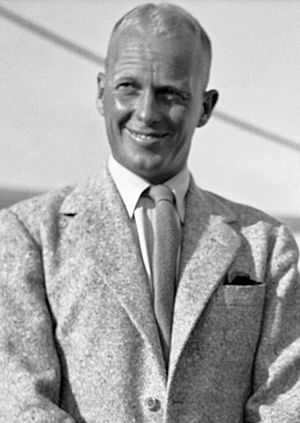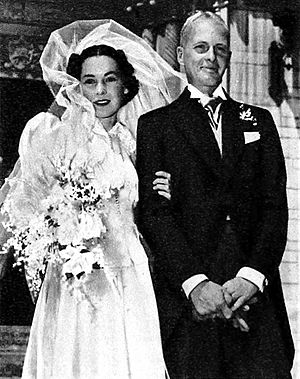John Farrow facts for kids
Quick facts for kids
John Farrow
|
|
|---|---|

Farrow in 1934
|
|
| Born |
John Villiers Farrow
10 February 1904 Sydney, New South Wales, Australia
|
| Died | 27 January 1963 (aged 58) |
| Resting place | Holy Cross Cemetery, Culver City |
| Occupation | Director, producer, screenwriter |
| Years active | 1927–1962 |
| Spouse(s) | |
| Children | 8, including Patrick, Mia, Prudence, and Tisa Farrow |
| Relatives | Ronan Farrow (grandson) |
John Villiers Farrow (born February 10, 1904 – died January 27, 1963) was a talented film director, producer, and writer from Australia. He spent much of his career working in the United States. In 1942, he was nominated for an Academy Award for Best Director for his movie Wake Island. Later, in 1957, he won an Academy Award for Best Adapted Screenplay for Around the World in Eighty Days. He had seven children with his wife, actress Maureen O'Sullivan, including the famous actress Mia Farrow.
Contents
Early Life and Adventures
John Farrow was born in Sydney, Australia. His mother passed away when he was very young. He went to school in Sydney and then started a job in accounting.
But John was an adventurous spirit! He often said he ran away to sea on an American ship. He claimed to have sailed all over the Pacific Ocean and even been part of revolts in Nicaragua and Mexico. He traveled to many places like Fiji, Hawaii, and Guam. When he arrived in Hollywood, he sometimes made up stories about his education, saying he went to famous schools in Australia, England, and the U.S. Navy.
Becoming a Writer
John Farrow started writing when he was a sailor. He became very interested in writing for movies after meeting filmmaker Robert J. Flaherty during a trip in the South Seas. When he got to Hollywood around 1927, his knowledge of ships and the sea helped him get jobs as a script consultant and technical advisor for films. He was already known a little for his poems and short stories.
Soon, he became a well-known screenwriter. He worked on titles for silent films like White Gold (1927) and wrote stories for movies such as The Blue Danube (1928).
Working for Big Studios
At Paramount, Farrow wrote many films, including those starring famous actresses like Clara Bow in Three Weekends (1928) and Pola Negri in The Woman from Moscow (1928). He also wrote for Gary Cooper in films like The First Kiss (1928) and Wolf Song (1929).
He also worked a lot for RKO. There, he wrote The Common Law (1931), which was a big success.
Time in Britain
In 1932, John Farrow went to England. He worked on films there and even helped as an assistant director for the movie Don Quixote (1933). He also wrote a novel called Laughter Ends (1933).
Back to Hollywood
After his time in England, Farrow returned to Hollywood and continued his work as a screenwriter. He wrote for movies like Last of the Pagans (1935), which was partly set in Tahiti.
Becoming a Film Director
John Farrow wanted to direct movies, and in 1936, he signed a deal with Warner Bros.. He finally directed his first movie in 1937, called Men in Exile.
After this, he traveled to Europe with his wife, Maureen O'Sullivan. He also wrote a book about Father Damien, a priest who helped people with leprosy.
Directing "B" Movies
When he came back to Hollywood, Farrow directed many "B-pictures" for Warner Bros. These were often smaller, faster-made films. He worked with actors like Boris Karloff in West of Shanghai (1937) and Ann Sheridan in She Loved a Fireman (1937). He directed Little Miss Thoroughbred (1938), which was the first film for young actress Peggy Ann Garner.
Success at RKO
Farrow then moved to RKO as a director. He directed The Saint Strikes Back (1939), which was the second film in "The Saint" series and the first to star George Sanders. He also directed Five Came Back (1939), which was a surprise hit and received great reviews, even though it was a "B" movie.
He said he wanted to make movies that earned money. He believed that making successful films would give him more freedom to direct the kinds of movies he truly wanted to make. He went on to direct other films like Full Confession (1939) and A Bill of Divorcement (1940), which was a remake of an earlier film.
Serving in World War II
Even though his movie career was doing well and he had just become a father, John Farrow wanted to help during World War II. In 1939, he joined the Canadian Navy. He was made a lieutenant and worked on anti-submarine patrols. He even served with the Royal Navy in Trinidad.
However, he became very sick with typhus fever and had to leave the navy in 1942. He was very ill, but his wife helped him get better. Because of his illness, he couldn't return to active service.
Directing "A" Movies at Paramount
After recovering, Farrow returned to directing at Paramount. The head of the studio was very impressed with his earlier film Five Came Back. For the first time, Farrow was directing only "A" movies, which were bigger and more important productions. His first film for Paramount was Wake Island (1942), a war film that earned him an Oscar nomination for Best Director and was one of the biggest hits of the year.
He continued to direct successful war films like Commandos Strike at Dawn (1942) and China (1943), starring Alan Ladd and Loretta Young. In 1943, he signed a long-term contract with Paramount. He directed The Hitler Gang (1944) and Two Years Before the Mast (1946), which was one of the most popular movies of 1946.
Film Noir and Westerns
In 1947, Farrow directed one of his most famous films, the crime thriller The Big Clock (1948), starring Ray Milland and his wife, Maureen O'Sullivan. He also directed other "film noir" movies, which are dark and moody crime dramas, such as Night Has a Thousand Eyes (1948) and Alias Nick Beal (1949).
He also directed popular Westerns like Copper Canyon (1950) with Ray Milland. In 1947, John Farrow became an American citizen.
Working as a Freelancer
After his contract with Paramount ended, Farrow worked as a freelance director. He directed Robert Mitchum in the film noir Where Danger Lives (1950). He also directed two films for actor John Wayne's company: Plunder of the Sun (1953) and the very popular Western Hondo (1953).
He had another big hit with John Wayne in The Sea Chase (1955), where Wayne played a German sea captain during World War II. Part of this movie was set in Sydney, Australia, Farrow's home country.
John Farrow was the first director for the movie Around the World in 80 Days (1956). Even though he was later replaced, he still received credit for his work on the screenplay, which won an Oscar!
He also wrote a collection of poetry and a book about Sir Thomas More.
Personal Life
John Farrow married actress Maureen O'Sullivan on September 12, 1936. They had seven children together. Four of their daughters became actresses: Mia Farrow (born 1945), Prudence Farrow (born 1948), Stephanie (born 1949), and Tisa Farrow (born 1951). They also had three sons: Michael Damien (1939–1958), Patrick Villiers Farrow (1942–2009), and John Charles (born 1946). John Farrow often wrote about Catholic themes in his books.
Death
John Farrow passed away from a heart attack in Beverly Hills, California, on January 27, 1963, when he was 58 years old. He is buried in the Holy Cross Cemetery, Culver City.
Awards and Honours
- He was made a Knight Grand Cross of the Order of the Holy Sepulchre by Pope Pius XI in 1937.
- He received an Oscar nomination and the New York Film Critics Circle Award for directing Wake Island (1942).
- He was given the Order of St John of Jerusalem in 1951.
- He was made an Honorary Commander of the Order of the British Empire (CBE) in 1953.
- He won an Oscar and a Writers Guild of America Award for his screenplay for Around the World in Eighty Days (1956).
- He has a star on the Hollywood Walk of Fame at 6304 Hollywood Blvd.
Australian Connection
As one of the few well-known Australians in Hollywood during the 1930s, John Farrow's activities were often reported in Australian news. He accepted the Oscar for the Australian documentary Kokoda Front Line! (1943). He also often said he wanted to make a film back in Australia. Later, he directed two movies with Australian connections: Botany Bay (1953) and The Sea Chase (1955).
Books and Plays
John Farrow was also a talented writer of books and plays:
- The Bad Ones (1930) – a novel
- Laughter Ends (1933) – a novel
- Damien the Leper (1937) – a biography about Father Damien
- The Royal Canadian Navy 1908–1940 (1940) – a history book
- Pageant of the Popes (1950) – a history of the papacy
- Seven Poems in Pattern (1955) – a collection of poetry
- Story of Sir Thomas More (1956) – a biography about Thomas More
- A Registered Woman (1931) – a play
Images for kids
See also
 In Spanish: John Farrow para niños
In Spanish: John Farrow para niños




